Player settings for the Universal Windows platform
This page details the Player settings specific to the Universal Windows platformAn IAP feature that supports Microsoft’s In App Purchase simulator, which allows you to test IAP purchase flows on devices before publishing your application. More info
See in Glossary. For a description of the general Player settings, see Player SettingsSettings that let you set various player-specific options for the final game built by Unity. More info
See in Glossary.
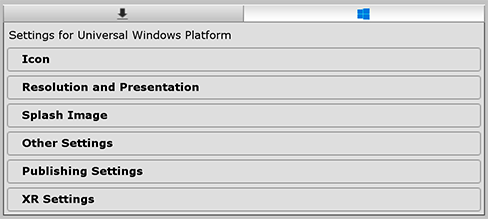
You can find documentation for the properties in the following sections:
Icon
Use the Icon settings to customize the branding for your app on the Windows Store.
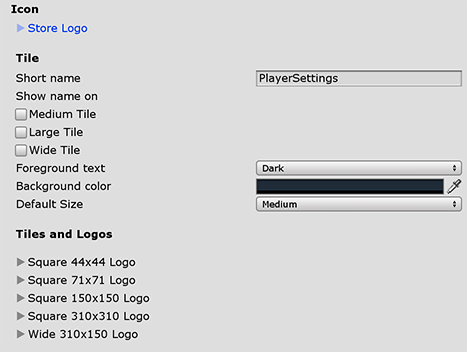
Expand the Store Logo section to specify the image that appears on the Store description page for the application. You can add up to eight different resolutions.
Tile section
Customize the general appearance of your Windows Store tiles with these settings:
| Setting | Function | |
|---|---|---|
| Short name | Set an abbreviated name for the app. | |
| Show name on | Indicate each icon image you want the name to appear on: Medium Tile, Large Tile, or Wide Tile. | |
| Foreground text | Choose whether you want to use Light or Dark text on the app’s Tile. | |
| Background color | Specify what color you want to use for the background. | |
| Default Size | Choose what size you want to use as the default size for the Tile. | |
| Not Set | Don’t use a default size. | |
| Medium | Use a medium size. | |
| Wide | Use a wide size. | |
Unity copies these options directly to the Package.appxmanifest file.
Tiles and Logos section
Specify the images your tiles display on the Windows Store with these settings:
| Setting | Function |
|---|---|
| Square 44x44 Logo | Set a 44x44 logo image to use on the app’s tile. You can set up to 10 resolutions. |
| Square 71x71 Logo | Set a 71x71 logo image to use on the app’s tile. You can set up to 5 resolutions. |
| Square 150x150 Logo | Set a 150x150 logo image to use on the app’s tile. You can set up to 5 resolutions. |
| Square 310x310 Logo | Set a 310x310 logo image to use on the app’s tile. You can set up to 5 resolutions. |
| Wide 310x150 Logo | Set a 310x150 logo image to use on the app’s tile. You can set up to 5 resolutions. |
Resolution and Presentation
Use the Resolution and Presentation section to customize aspects of the screen’s appearance.
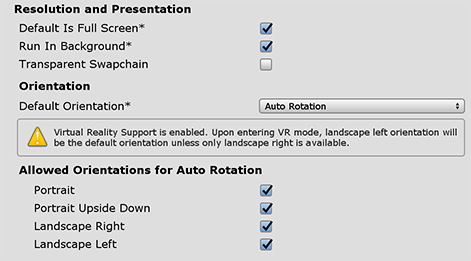
| Setting | Function |
|---|---|
| Default is Fullscreen | Set the window to the full-screen native resolution of the display. Unity renders app content at the resolution set by script (or by user selection when the built application launches), but scales it to fill the window. When scaling, Unity adds black bars to the rendered output to match the aspect ratioThe relationship of an image’s proportional dimensions, such as its width and height. See in Glossary chosen in the Player settings, so that the content isn’t stretched. This process is called letterboxing. |
| Run In background | Enable this option to make the game keep running (rather than pausing) if the app loses focus. |
| Transparent Swapchain | Sets AlphaMode on the swap chain to DXGI_ALPHA_MODE_PREMULTIPLIED. This setting is only used for UWP projects that use the XAML build type. By enabling this setting, you can compose Unity content with other XAML content in your application. For more information, see the PlayerSettings.WSA.transparentSwapchain. |
Orientation
Choose the game’s screen orientation from the Default Orientation drop-down menu:
| Setting | Function |
|---|---|
| Portrait | Orient the screen so that the device’s Home button appears at the bottom. |
| Portrait Upside Down | Orient the screen so that the device’s Home button appears at the top. |
| Landscape Left | Orient the screen so that the device’s Home button appears on the right side. |
| Landscape Right | Orient the screen so that the device’s Home button appears on the left side. |
| Auto Rotation | Screen orientation changes with device orientation. This is the default. |
When you set the orientation to Auto Rotation, the Allowed Orientations for Auto Rotation section appears.
Allowed Orientations for Auto Rotation
This section is only visible when Default Orientation is set to Auto Rotation.
Because Auto Rotation changes screen orientation to match the device, you may want to limit the screen orientations allowed (for example, locking a device to landscape).
Enable each orientation you want to allow by checking its box in this section:
| Setting | Function |
|---|---|
| Portrait | Allow portrait orientation. |
| Portrait Upside Down | Allow portrait upside-down orientation. |
| Landscape Right | Allow landscape right orientation (home button on the left side). |
| Landscape Left | Allow landscape left orientation (home button is on the right side). |
Splash Image
Above the common Splash Screen settings, the Player Settings settings allow you to specify splash images for the Universal Windows platform.

Use the Virtual Reality Splash Image property to select a custom splash image to be displayed in Virtual RealityA system that immerses users in an artificial 3D world of realistic images and sounds, using a headset and motion tracking. More info
See in Glossary displays.
Below the common Splash Screen settings, there are a few additional sections:
- Windows
- Windows HolographicThe former name for Windows Mixed Reality. More info
See in Glossary - Overwrite background color
Windows
Set the foreground image you want to use in your app’s splash screen. You can add up to seven different resolutions.
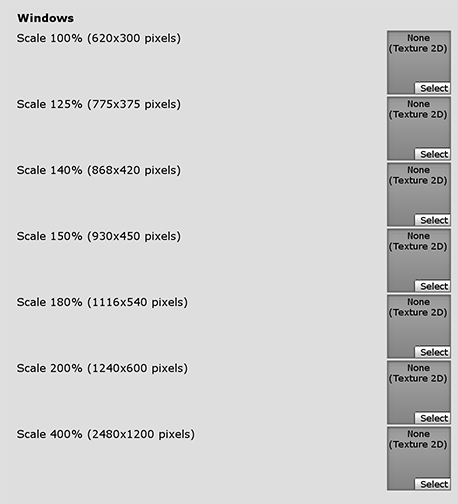
Windows Holographic
Use these settings to customize the holographic splash image for Mixed Reality apps.
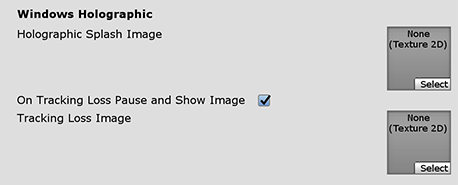
Set a Holographic Splash Image to appear during startup. This image appears for five seconds (or until the app finishes loading).
Tracking Loss
A Mixed Reality headset needs to build world-locked coordinate systems from its environment, in order to allow holograms to stay in position. Tracking loss occurs when the headset loses track of where it is (can’t locate itself) in the world. This leads to a breakdown in spatial systems (spatial mapping, spatial anchors, spatial stages).
When this happens, Unity stops rendering holograms, pauses the game, and displays a notification. You can customize the notification image that appears by enabling the On Tracking Loss Pause and Show Image property, and then selecting the image to display with the Tracking Loss Image property.
For more information, see Recommended settings for Unity.
Overwrite background color
The common Splash Screen settings allow you to set the Background Color for when no background image is set, which applies to all platforms.

To override this for the Universal Windows platform, you can enable the Overwrite background color property and then use the Background color setting to choose a different color.
Other Settings
This section allows you to customize a range of options organized into the following groups:
- RenderingThe process of drawing graphics to the screen (or to a render texture). By default, the main camera in Unity renders its view to the screen. More info
See in Glossary - Configuration
- Optimization
- Logging
- Legacy
Rendering
Use these settings to customize how Unity renders your game for the Univeral Windows platform.
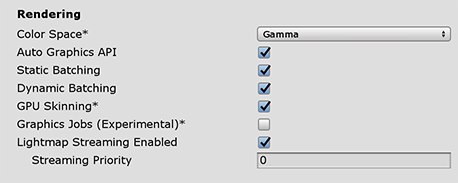
| Setting | Function |
|---|---|
| Color Space | Choose which color space should be used for rendering: Gamma or Linear. See the Linear rendering overview for an explanation of the difference between the two. |
| Auto Graphics API | Disable this option to manually pick and reorder the graphics APIs. By default this option is enabled, and Unity uses Direct3D11. |
| Static BatchingA technique Unity uses to draw GameObjects on the screen that combines static (non-moving) GameObjects into big Meshes, and renders them in a faster way. More info See in Glossary |
Enable this option to use Static batching. |
| Dynamic BatchingAn automatic Unity process which attempts to render multiple meshes as if they were a single mesh for optimized graphics performance. The technique transforms all of the GameObject vertices on the CPU and groups many similar vertices together. More info See in Glossary |
Enable this option to use Dynamic Batching (activated by default). |
| GPU Skinning | Enable this option to use DX11/ES3 GPU skinningThe process of binding bone joints to the vertices of a character’s mesh or ‘skin’. Performed with an external tool, such as Blender or Autodesk Maya. More info See in Glossary. |
| Graphics Jobs (Experimental) | Enable this option to instruct Unity to offload graphics tasks (render loops) to worker threads running on other CPU cores. This is intended to reduce the time spent in Camera.Render on the main thread, which is often a bottleneck. Note: This feature is experimental. It may not deliver a performance improvement for your project, and may introduce new crashes. |
| Lightmap Streaming Enabled | Enable this option to load only the lightmap mip maps as needed to render the current game Cameras. This value applies to the lightmap textures as they are generated. Note: To use this setting, you must enable the Texture Streaming Quality setting. |
| Streaming Priority | Set the lightmap mip map streaming priority to resolve resource conflicts. These values are applied to the light map textures as they are generated. Positive numbers give higher priority. Valid values range from –128 to 127. |
Configuration
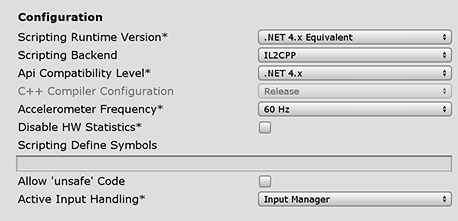
| Setting | Function | |
|---|---|---|
| Scripting Runtime Version | Choose which .NET runtime to use in your project. For more details, see Microsoft’s .NET documentation. | |
| .NET 3.5 Equivalent (Deprecated) | A .NET runtime which implements the .NET 3.5 API. This functionality is deprecated, and should no longer be used. Please use .NET 4. | |
| .NET 4.x Equivalent | A .NET runtime which implements the .NET 4 API. This API is newer than .NET 3.5, and as such, it offers access to more APIs, is compatible with more external libraries, and supports C# 6. This is the default scripting runtime. | |
|
Scripting BackendA framework that powers scripting in Unity. Unity supports three different scripting backends depending on target platform: Mono, .NET and IL2CPP. Universal Windows Platform, however, supports only two: .NET and IL2CPP. More info See in Glossary |
Choose the scripting backend you want to use. | |
| .NET | The standard .NET runtime. | |
| IL2CPP | Unity’s .NET runtime. This is the default. | |
| API Compatibility Level | There are two options for API compatibility level: .NET 4.0, or .NET Standard 2.0. Tip: If you are having problems with a third-party assembly, you can try the suggestion in the API Compatibility Level section below. |
|
| C++ Compiler Configuration | Choose the C++ compiler configuration used when compiling IL2CPP generated code. Note: This property is disabled for the Universal Windows platform. |
|
| Accelerometer Frequency | Define how often to sample the accelerometer. If you choose Disabled, then no samples are taken. Otherwise, you can choose from 15Hz, 30Hz, 60Hz and 100Hz frequencies. | |
| Disable HW Statistics | Enable this option to instruct the application not to send information about the hardware to Unity. For more details, see Unity Hardware Statistics. | |
| Scripting Define Symbols | Set custom compilation flags. For more details, see Platform dependent compilation. | |
| Allow ‘unsafe’ Code | Enable support for compiling ‘unsafe’ C# code in a pre-defined assembly (for example, Assembly-CSharp.dll). For Assembly Definition Files ( .asmdef), click on one of your .asmdef files and enable the option in the Inspector window that appears. |
|
| Active Input Handling | Choose how you want to handle input from users. | |
| Input Manager | Use the traditional Input settings. | |
| Input System (Preview) | Use the newer Input system. The Input System is under development. To try an early preview of the Input System, install the InputSystem package. If you select the Input System (Preview) option without having that package installed, nothing happens except for some extra processing. | |
| Both | Use both systems side by side. | |
Optimization
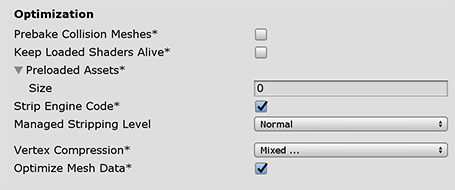
| Setting | Function | |
|---|---|---|
| Prebake Collision Meshes | Enable this option to add collisionA collision occurs when the physics engine detects that the colliders of two GameObjects make contact or overlap, when at least one has a rigidbody component and is in motion. More info See in Glossary data to Meshes at build time. |
|
| Keep Loaded Shaders Alive | Enable this option to prevent shadersA small script that contains the mathematical calculations and algorithms for calculating the Color of each pixel rendered, based on the lighting input and the Material configuration. More info See in Glossary from being unloaded. |
|
| Preloaded Assets | Set an array of Assets for the player to load on startup. To add new Assets, increase the value of the Size property and then set a reference to the Asset to load in the new Element box that appears. |
|
| Strip Engine Code | Enable code stripping. This setting is only available with the IL2CPP Scripting Backend. Most games don’t use all necessary DLLs. With the Strip Engine Code option enabled, you can strip out unused parts to reduce the size of the built player on iOS devices. If your game is using classes that would normally be stripped out by the option you currently have selected, you’ll be presented with a Debug message when you make a build. |
|
| Managed Stripping Level | Choose how aggressively Unity strips unused managed (C#) code. | |
| Normal | Remove unreachable managed code to reduce build size and .NET/IL2CPPA Unity-developed scripting back-end which you can use as an alternative to Mono when building Projects for some platforms. More info See in Glossary build times. |
|
| Aggressive | Run UnityLinker in a less conservative mode than normal, reducing code size even further than what Normal can achieve. However, this additional reduction may come with tradeoffs. For more information, see ManagedStrippingLevel. | |
| Vertex Compression | Set vertex compressionA method of storing data that reduces the amount of storage space it requires. See Texture Compression3D Graphics hardware requires Textures to be compressed in specialised formats which are optimised for fast Texture sampling. More info See in Glossary, Animation CompressionThe method of compressing animation data to significantly reduce file sizes without causing a noticable reduction in motion quality. Animation compression is a trade off between saving on memory and image quality. More info See in Glossary, Audio Compression, Build Compression. See in Glossary per channel. For example, you can enable compression for everything except positions and lightmapA pre-rendered texture that contains the effects of light sources on static objects in the scene. Lightmaps are overlaid on top of scene geometry to create the effect of lighting. More info See in Glossary UVs. Whole MeshThe main graphics primitive of Unity. Meshes make up a large part of your 3D worlds. Unity supports triangulated or Quadrangulated polygon meshes. Nurbs, Nurms, Subdiv surfaces must be converted to polygons. More info See in Glossary compression set per imported object overrides where vertex compression is set on objects. Everything else obeys these vertex compression settings. |
|
| Optimize Mesh Data | Enable this option to remove any data from Meshes that is not required by the Material applied to them (such as tangents, normals, colors, and UVs). | |
Logging
Select what type of logging to allow in specific contexts.
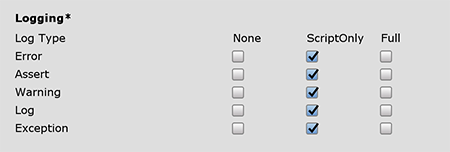
Check one box that corresponds to each Log Type (Error, Assert, Warning, Log, and Exception) when running scriptsA piece of code that allows you to create your own Components, trigger game events, modify Component properties over time and respond to user input in any way you like. More info
See in Glossary (ScriptOnly) , all the time (Full), or never (None).
Legacy
Enable the Clamp BlendShapes (Deprecated) option to clamp the range of Blend Shape weights in SkinnedMeshRenderers.

Publishing Settings
Use these settings to customize building your Universal Windows app. These options are organized into the following groups:
- Packaging
- Certificate
- Streaming Install
- Application UI
- File and Protocol Associations
- Compilation
- Misc
- Capabilities
- Supported Device Families
Unity stores these settings in the Package.appxmanifest file when creating a Visual Studio solution for the first time.
Note: If you build your project on top of the existing one, Unity doesn’t overwrite the Package.appxmanifest file if it’s already present. That means if you change any of the Player settings, you need to check Package.appxmanifest. If you want to regenerate Package.appxmanifest, delete it and rebuild your project from Unity.
For more information, see Microsoft’s documentation on App package manifest.
Supported orientations from Player Settings are also populated to the manifest (Package.appxmanifest file in Visual Studio solution). On Universal Windows Apps, Unity resets the orientation to the one you used in the Player settings, regardless of what you specify in the manifest. This is because Windows itself ignores those settings on desktop and tablet computers.
Tip: You can always change supported orientations using Unity scripting API.
Packaging
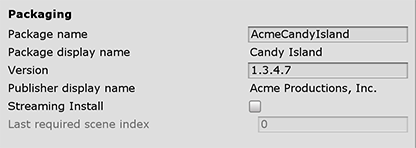
| Setting | Function |
|---|---|
| Package name | Enter the name to identify the package on the system. The name must be unique. |
| Package display name | The Product Name value that you set at the top of the Player settings appears here. This is the name of the app as it will appear on the Windows Store. |
| Version | Enter the version for the package using a string in quadA primitive object that resembles a plane but its edges are only one unit long, it uses only 4 vertices, and the surface is oriented in the XY plane of the local coordinate space. More info See in Glossary notation: Major.Minor.Build.Revision. |
| Publisher display name | The Company Name value that you set at the top of the Player settings appears here. This is the user-friendly name of the publisher. |
| Streaming Install | Enable this option to create a AppxContentGroupMap.xml manifest file containing streamable Assets for the Scene. To include Scene Assets by default, use the Last required scene index setting. Assets in Scenes with a scene index above the Last required scene index are specified as streamable in the manifest file.Note: This setting is only available with the IL2CPP Scripting Backend. |
| Last required scene index | Enter the index number from the Scenes In Build list on the Build Settings window that corresponds to the last scene in that list that must be present in the game build. For an application to start, Unity requires any scene index at or less than the specified index. To require all files in the list, use the index of the last scene in the list. Scenes with a greater scene index must include shared Assets for Scenes with a lesser index. The order of scenes in the Build Settings dialog may be important to allow the application to locate the required assets. Note: By default, the Streaming Install option is disabled, which means that this setting is not available. To make this property editable, enable the Streaming Install option first. |
Certificate
Every Universal Windows App needs a certificate which identifies a developer.

You can click the Select button to choose your certificate file (.pfx) from your local computer. The name of the file you selected appears on the Select button.
If you don’t have a certificate file already, you can generate a file in Unity:
-
Click the Create button. The Create Test Certificate for Windows Store dialog window appears.
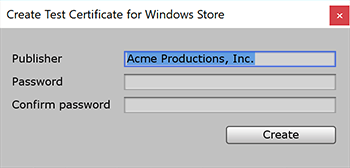
Enter the name of the package publisher in the Publisher text box.
Enter the password for the certificate in the Password text box and then again in the Confirm password text box.
-
Click the Create button.
The window closes and the Certificate section displays the name you entered for both the Publisher and Issued by values. The Expiration date is set to one year from the time you created the certificate.

Streaming Install
Your Microsoft UWP application supports Streaming Install if the Scripting Backend is using IL2CPP.
If you enable Streaming Install, Unity generates an AppxContentGroupMap.xml file containing streamable AssetsAny media or data that can be used in your game or Project. An asset may come from a file created outside of Unity, such as a 3D model, an audio file or an image. You can also create some asset types in Unity, such as an Animator Controller, an Audio Mixer or a Render Texture. More info
See in Glossary. To include Scene Assets in the AppxContentGroupMap.xml file by default, use the Last required scene index setting, which uses the scene index in the Build Settings dialog. Assets in ScenesA Scene contains the environments and menus of your game. Think of each unique Scene file as a unique level. In each Scene, you place your environments, obstacles, and decorations, essentially designing and building your game in pieces. More info
See in Glossary with a scene index above the Last required scene index are specified as streamable in the generated manifest. For an application to start, Unity requires any scene index at or less than the specified index.
Scenes with a greater scene index must include shared assets for Scenes with a lesser index. The order of scenes in the Build Settings dialog may be important to allow the application to locate the required assets.
Application UI
Unity copies these options directly to the Package.appxmanifest file.

The Dispay name value that you set at the top of the Player Settings settings appears in this section. This is the full name of the app.
Enter the text you want to appear on the app’s tile on the Windows Store in the Description text box. This defaults to the Package display name value.
File and Protocol Associations
The settings under the File Type Associations, File Types, and Protocol sections allow you to set up your Windows Store app as the default handler for a certain file type or URI scheme.
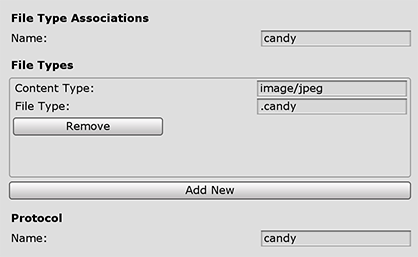
Under the File Type Associations section, enter the name (lowercase only) for a group of file types in the Name text box. These are files that share the same display name, logo, info tip, and edit flags. Choose a group name that can stay the same across app updates.
If you are setting this up as a file association:
- Click the Add New button. An empty entry appears in the File Types list. You can add multiple file types.
- Enter the MIME content type in the Content Type text box for a particular file type. For example, image/jpeg.
- Enter the file type to register for in the File Type text box, preceded by a period (for example, .jpeg).
If you are setting this up as an association with a URI scheme, enter the protocol in the Name text box.
For more information, see Auto-launching with file and URI associations (XAML)
Compilation

Unity uses Mono when compiling script files, and you can use the API located in .NET 4.x. To use .NET for Universal Windows Platform (also known as .NET Core) in your C# files, choose one of these values from the Compilation Overrides setting:
| Value | Function |
|---|---|
| None | Use the Mono compiler to compile C# files. |
| Use .Net Core | Use the Microsoft compiler and .NET Core to compile C# files. You can use Windows Runtime API, but classes implemented in C# files aren’t accessible from the JS language. Note: When using API from Windows Runtime, it’s advisable to wrap the code with the ENABLE_WINMD_SUPPORT define, because the API is only available when building for the Universal Windows Platform, and it’s not available in Unity Editor. |
| Use .Net Core Partially | Use the Microsoft compiler and .NET Core to compile any C# files not located in Plugins, Standard Assets, and Pro Standard Assets folders. For all other C# files, use the Mono compiler. The advantage is that classes implemented in C# are accessible from the JS language. Note: You can’t test the .NET Core API in Unity Editor, because it doesn’t have access to .NET Core, which means you can only test the API only when running Universal Windows App. |
Note: You cannot use .NET Core API in JS scripts.
Here’s a simple example of how to use .NET Core API in scripts.
string GetTemporaryFolder()
{
#if ENABLE_WINMD_SUPPORT
return Windows.Storage.ApplicationData.Current.TemporaryFolder.Path;
#else
return "LocalFolder";
#endif
}
Misc
Unity receives input by subscribing to events. The Input Source setting defines where (which sources) to get input from. Currently this only applies to mouse and touch input, as keyboard input always comes from CoreWindow.

| Value | Function |
|---|---|
| CoreWindow | Subscribe to CoreWindow events. This is the default. |
| Independent Input Source | Create Independent Input Source and receive input from it. |
| SwapChainPanel | Subscribe to SwapChainPanel events. |
Capabilities
Use the Capabilities section to enable APIs or resources you want your app to access. These could be pictures, music, or devices such as the cameraA component which creates an image of a particular viewpoint in your scene. The output is either drawn to the screen or captured as a texture. More info
See in Glossary or the microphone.
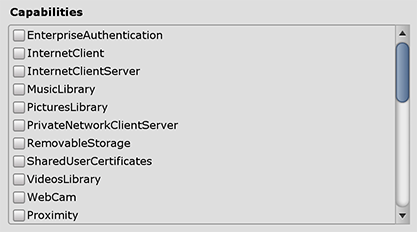
| Capability | Function |
|---|---|
| EnterpriseAuthentication | Windows domain credentials enable a user to log into remote resources using their credentials, and act as if a user provided their user name and password. |
| InternetClient | Apps can receive incoming data from the Internet. Cannot act as a server. No local network access. |
| InternetClientServer | Same as InternetClient but also enables peer-to-peer (P2P) scenarios where the app needs to listen for incoming network connections. |
| MusicLibrary | Accesses the user’s Music, allowing the app to enumerate and access all files in the library without user interaction. This capability is typically used in jukebox apps that make use of the entire Music library. |
| PicturesLibrary | Accesses the user’s Pictures, allowing the app to enumerate and access all files in the library without user interaction. This capability is typically used in photo apps that make use of the entire Pictures library. |
| PrivateNetworkClientServer | Provides inbound and outbound access to home and work networks through the firewall. This capability is typically used for games that communicate across the local area network (LAN), and for apps that share data across a variety of local devices. |
| RemovableStorage | Accesses files on removable storage, like USB keys and external hard drives. |
| SharedUserCertificates | Allows your app to add and access software and hardware-based certificates in the Shared User store, such as certificates stored on a smart card. This capability is typically used for financial or enterprise apps that require a smart card for authentication. |
| VideosLibrary | Accesses the user’s Videos, allowing the app to enumerate and access all files in the library without user interaction. This capability is typically used in movie-playback apps that make use of the entire Videos library. |
| WebCam | Accesses the video feed of a built-in camera or external webcam, which allows the app to capture photos and videos. Note: This only grants access to the video stream. In order to grant access to the audio stream as well, the Microphone capability must be added. |
| Proximity | Enables multiple devices in close proximity to communicate with one another. This capability is typically used in casual multi-player games and in apps that exchange information. Devices attempt to use the communication technology that provides the best possible connection, including Bluetooth, Wi-Fi, and the Internet. |
| Microphone | Accesses the microphone’s audio feed, which allows the app to record audio from connected microphones. |
| Location | Accesses location functionality that retrieved from dedicated hardware like a GPS sensor in the PC or derived from available network info. |
| HumanInterfaceDevice | Enables access to Human Interface Device APIs. See How to specify device capabilities for HID for details. |
| AllJoyn | Allows AllJoyn-enabled apps and devices on a network to discover and interact with each other. |
| BlockedChatMessages | Allows apps to read SMS and MMS messages that have been blocked by the Spam Filter app. |
| Chat | Allows apps to read and write all SMS and MMS messages. |
| CodeGeneration | Allows apps to access the following functions which provide JIT capabilities to apps VirtualProtectFromApp CreateFileMappingFromApp OpenFileMappingFromApp MapViewOfFileFromApp |
| Objects3D | Allows apps to have programmatic access to the 3D object files. This capability is typically used in 3D apps and games that need access to the entire 3D objectsA 3D GameObject such as a cube, terrain or ragdoll. More info See in Glossary library. |
| PhoneCall | Allows apps to access all of the phone lines on the device and perform the following functions. Place a call on the phone line and show the system dialer without prompting the user. Access line-related metadata. Access line-related triggers. Allows the user-selected spam filter app to set and check block list and call origin information. |
| UserAccountInformation | Accesses the user’s name and picture. |
| VoipCall | Allows apps to access the VOIP calling APIs in the Windows.ApplicationModel.Calls namespace. |
| Bluetooth | Allows apps to communicate with already paired bluetooth devices over both Generic Attribute (GATT) or Classic Basic Rate (RFCOMM) protocol. |
| SpatialPerception | Provides programmatic access to spatial mappingThe process of mapping real-world surfaces into the virtual world. More info See in Glossary data, giving mixed reality apps information about surfaces in application-specified regions of space near the user. Declare the spatialPerception capability only when your app will explicitly use these surface meshes, as the capability is not required for mixed reality apps to perform holographic rendering based on the user’s head pose. |
| InputInjectionBrokered | Allows apps to inject various forms of input such as HID, touch, pen, keyboard or mouse into the system programmatically. This capability is typically used for collaboration apps that can take control of the system. |
| Appointments | Accesses the user’s appointment store. This capability allows read access to appointments obtained from the synced network accounts and to other apps that write to the appointment store. With this capability, your app can create new calendars and write appointments to calendars that it creates. |
| BackgroundMediaPlayback | Changes the behavior of the media-specific APIs like the MediaPlayer and AudioGraph classes to enable media playback while your app is in the background. All active audio streams will no longer mute, but will continue to be audible when an app transitions to the background. Additionally, app lifetime will be extended automatically while playback is occurring. |
| Contacts | Accesses the aggregated view of the contacts from various contacts stores. This capability gives the app limited access (network permitting rules apply) to contacts that were synced from various networks and the local contact store. |
| LowLevelDevices | Allows apps to access custom devices when a number of additional requirements are met. |
| OfflineMapsManagement | Allows apps to access offline maps. |
| PhoneCallHistoryPublic | Allows apps to read cellular and some VOIP call history information on the device. This capability also allows the app to write VOIP call history entries. |
| PointOfService | Enables access to APIs in the Windows.Devices.PointOfService namespace. This namespace lets your app access Point of Service (POS) barcode scanners and magnetic stripe readers. The namespace provides a vendor-neutral interface for accessing POS devices from various manufacturers from a UWP app. |
| RecordedCallsFolder | Allows apps to access the recorded calls folder. |
| RemoteSystem | Allows apps to have access to a list of devices associated with the user’s Microsoft Account. Access to the device list is necessary to perform any operations that persist across devices. |
| SystemManagement | Allows apps to have basic system administration privileges such as shutting down or rebooting, locale, and timezone. |
| UserDataTasks | Allows apps to have access to the current state of the tasks setting. |
| UserNotificationListener | Allows apps to have access to the current state of the notifications setting. |
For more information, see App capability declarations
Unity copies these options directly to the Package.appxmanifest file.
Note: If you build your game on top of previous package, Package.appxmanifest won’t be overwritten.
Supported Device Families
A device family identifies the APIs, system characteristics, and behaviors across a class of devices. It also determines the set of devices on which your app can be installed from the Store. See Microsoft’s Device families overview for more information.
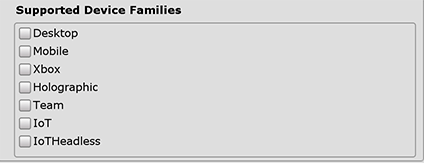
| Setting | Function |
|---|---|
| Desktop | Windows Desktop Extension SDK API contracts for UWP |
| Mobile | Windows Mobile Extension SDK API contracts for UWP |
| Xbox | Xbox Live Extension SDK API contracts for UWP |
| HolographicThe former name for Windows Mixed Reality. More info See in Glossary |
HololensAn XR headset for using apps made for the Windows Mixed Reality platform. More info See in Glossary (self-contained, holographic computer) used for Mixed Reality apps |
| Team | Windows Team Extension SDK API contracts for UWP. This is commonly used for Microsoft Surface Hub devices. |
| IoT |
Windows IoT Extension SDK API contracts for UWP. Note Currently, apps targeting IoT or IoTHeadless are not valid in the app store and should be used for development purposes only. |
| IoTHeadless | Similar to IoT but without any UI. Note Currently, apps targeting IoT or IoTHeadless are not valid in the app store and should be used for development purposes only. |
For more information, see Device family availability.
XR Settings
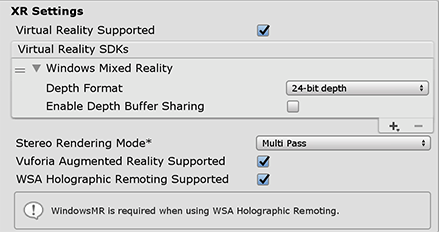
| Property: | Function: | |
|---|---|---|
| Virtual Reality Supported | Enable native VR support for the Unity Editor and your game builds. | |
| Virtual Reality SDKs | Add and remove Virtual Reality SDKs from the list. This list is only available available when the Virtual Reality Supported is enabled. To add an SDK to the list, click the plus (+) button. To remove an SDK from the list, select it and then click the minus (-) button. Some of the SDKs provide extra settings that appear here. For details, see XR SDKs. |
|
| Stereo Rendering Mode | Choose how you want to render for a virtual reality device. | |
| Multi Pass | This is the normal rendering modeA Standard Shader Material parameter that allows you to choose whether the object uses transparency, and if so, which type of blending mode to use. More info See in Glossary. Unity renders the Scene twice: first to render the left-eye image; and then again for the right-eye image. |
|
| Single Pass | Render both eye images at the same time into one packed Render TextureA special type of Texture that is created and updated at runtime. To use them, first create a new Render Texture and designate one of your Cameras to render into it. Then you can use the Render Texture in a Material just like a regular Texture. More info See in Glossary. This means that the whole Scene is only rendered once, which significantly reduces CPU processing time. |
|
| Single Pass Instanced (Preview) | The GPU performs a single render pass, replacing each draw call with an instanced draw call. This heavily decreases CPU use, and slightly decreases GPU use, due to the cache coherency between the two draw calls. Using this mode significantly reduces the power consumption of your application. | |
| Vuforia Augmented Reality Supported | Enable this option to use Vuforia Augmented Reality SDK, which is required when using the Vuforia Virtual Reality SDK. | |
| WSA Holographic Remoting Supported | Enable this option to use WSA Holographic Remoting. To use this, you must add the Windows Mixed RealityA mixed reality platform developed by Microsoft, built around the API of Windows 10. More info See in Glossary SDK. |
|
- 2018–10–15 Page amended with limited editorial review
- Support for Universal Windows Platform streaming install added in 2018.3 NewIn20183
Did you find this page useful? Please give it a rating: